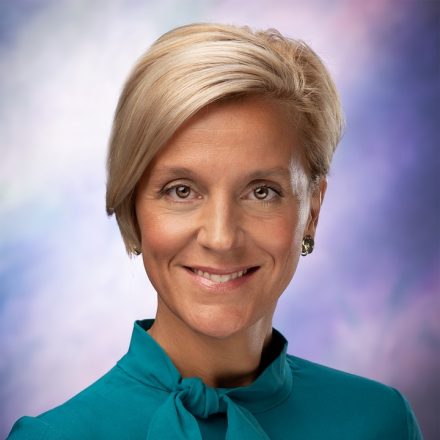- This video doorbell camera has just as many features are my Ring - and no subscription required
- LG is giving away free 27-inch gaming monitors, but this is the last day to grab one
- I tested this Eufy security camera and can't go back to grainy night vision
- I replaced my iPhone with a premium dumbphone - here's my verdict after a month
- Build your toolkit with the 10 DIY gadgets every dad should have
IT leaders’ top 15 takeaways from 2021

Every year has its twists and turns, but 2021 — like its predecessor — was filled with more than the usual number of memorable events and seismic changes, from inflation and supply chain issues to the Great Resignation and the ongoing effects of the pandemic.
So, after another turbulent year, we asked a handful of CIOs to look back at what the past 12 months have taught them. Here they give their top takeaways from 2021.
1. Unpredictability and constant change are the new norm
Kathy Kay, CIO, Principal Financial Group
Principal Financial Group
Kathy Kay, CIO at Principal Financial Group, suspects many people will look back at their January 2021 expectations for the year and realize how off they were. “How we thought the year was going to end is much different than how it’s actually ending,” she says.
Given that fact, Kay says she and other CIOs must always be ready for change. She acknowledges that the need for this trait isn’t new, but it became increasingly critical during the past year that was as unpredictable as the year prior.
Kay has been preparing for this new era of constant change — whether driven by customer demands or world events — by modernizing and simplifying the company’s technology stack and focusing on continually upskilling her workers. That way, she says, Principal Financial Group will be well positioned to handle what’s just around the corner.
“Today it’s all about being a flexible leader. We need to have the ability to pivot. It has to be part of how we move forward,” she says.
2. IT must move faster

Ryan Smith, CIO, Intermountain Healthcare
Intermountain Healthcare
On a related note, the past year has shown that CIOs must be not only flexible but fast, says Ryan Smith, vice president and CIO at Intermountain Healthcare.
“Digital transformation is accelerating the pace of business, requiring IT to increase its pace and alignment with operational leaders across the business,” he explains. “The IT team must continue to reskill itself and build expertise in digital technologies like AI, robotic process automation, cloud, mobile, ambient intelligence, etc.”
3. Agile is a must — more than ever

Meerah Rajavel, CIO, Citrix
Citrix
Similarly, the past year has shown the criticality of agile principles to engender flexibility and speed in the IT function itself, says Citrix CIO Meerah Rajavel.
“We’re doubling down on our efforts to be nimble to keep pace with the uncertainty and constant shifting in the macro environment that persists, leveraging methods like Scaled Agile Framework [SAFe] with appropriate tools to support execution,” she adds.
4. CIOs have a key role in helping the workforce
With the Great Resignation under way, CIOs can make a difference. Consider the perspective of Stephanie Lahr, MD, chief information officer and chief medical information officer at Monument Health, who says workforce recruitment and retention is at a crisis point in healthcare.
“With rising burnout, the rising intensity of the work itself, and new opportunities for people to work remotely, every health system is struggling to find the people they need in clinical and nonclinical roles,” she explains. “Given that new paradigm, we will have to reinvent how work is done so that we can continue to deliver high-quality care with a shrinking number of people.”

Monument Health
Moreover, she says, companies need to make their organizations the best possible places to work to give workers a reason to stay. For CIOs like Lahr, that means using technology to streamline operations, remove unnecessary tasks, create workplace efficiencies, and deliver an overall better employee experience — all in the name of helping overly taxed workers do their jobs better and find more satisfaction and fulfillment in doing them.
“Technology is going to be the major enabler of reinventing how healthcare is delivered, and we need to [strategize] how that can be done in a way that brings the joy back to medicine,” Lahr says. “Automation and AI will be the key tools needed, and exceptional leadership to impact change management will be a requirement.”
She adds: “Within my own IT workforce we will explore our own opportunities for automation of simple tasks, allowing caregivers to focus on higher level processes and using their knowledge to creatively solve problems, which tends to be more rewarding than the routine maintenance of our systems. We will also continue to evaluate how and even when and where work can be done to provide the highest levels of flexibility to accommodate the evolving needs of caregivers and their families.”
5. Remote work is here to stay

Jason Conyard, CIO, VMware
VMware
The pandemic forced organizations to implement remote work options; but this year showed they must continue offering that choice, even after pandemic concerns recede, because workers demand it.
“We have to recognize that it’s a competitive necessity because talent is so hot, that’s not a US or tech phenomena but a global phenomenon. So, providing employees with flexibility around the world is essential,” says Jason Conyard, CIO of VMware.
He adds that as a CIO he’s focus on ensuring that hybrid teams have the tools and best practices they need to work effectively together — no matter where they’re based.
6. It’s time to reassess successes
“My key takeaway from 2021 was that everything we did to stay functional in 2020 didn’t need to become part of our toolkit,” says Jack McCarthy, CIO, State of New Jersey – Judiciary.

Jack McCarthy, CIO, State of New Jersey–Judiciary
State of New Jersey–Judiciary
“In March 2020 I described our success as six months of work in six days based on six years of planning. The successes we had in 2020 were due to making the right decisions on cloud, infrastructure, and collaboration in the years before,” he explains. “In 2021 we did an introspective review of all the changes we made in 2020. Those that had merit, like automation, stayed and were imported into our enterprise toolkits. Those that didn’t were ejected. We carry technical baggage from decisions made in past decades and it was important to not add things that were only helpful in getting us through 2020.”
7. CIOs must be business leaders first
“It has become even more apparent that technology leaders must also be business leaders aligning to enablement of a strategy as the key deliverable of their team,” says Chris Campbell, CIO of DeVry University.
Like workers everywhere, Campbell saw both the company’s working and operating styles change during the pandemic, with those changes now becoming permanent. That has “made understanding the operations and aligning initiatives to business outcomes more critical in order to maintain relevance and provide value to business partners.”
He acknowledges that this CIO-as-business-leader requirement has been developing for a while but has accelerated in the past two years.

Chris Campbell, CIO, DeVry University
DeVry University
CIOs now must be able to rapidly make appropriate decisions regarding significant transformation projects — something that demands they act from a business perspective to better ensure success and desired outcomes, he says.
Moreover, Campbell notes that “in many ways the social networks that traditionally made up for lack of business understanding in IT professionals have deteriorated, which has made it necessary for IT professionals to not only understand the business but also to educate their peers in how technology can advance the outcomes of the company.”
To counter that, Campbell is having his direct reports strengthen their business leadership through stretch opportunities driving non-technology projects within the company.
8. Composable architecture is a must
Another big takeaway from 2021 for Campbell: the need for composable architecture to allow quick pivots.
“We experienced two separate occasions that required both the change in a software product we use as well as updates to integrations to support the business process,” he explains. “In both situations we were dealing with legacy point-to-point integrations and products that did not have native API capability. These two situations slowed our response to market opportunities so much that the opportunity was missed in one case and in the second case operational risk was not sufficiently mitigated, resulting in other outcome challenges.”
Those experiences and the insight they provided are shaping his plans for 2022.
“We were already on a roadmap to shift to an API-based architecture, along with some data aggravation changes, to support a more composable architecture. We are also moving up transformation projects for legacy products that are not supporting faster change via their architecture,” he says, predicting that more than 20% of his application vendors and products will change in the next 18 months to support this IT plan.
9. Employee experience can be a talent magnet
“The pandemic has intensified the battle for talent, and employee experience has never mattered more,” says Citrix’s Rajavel. “In today’s environment, talent strategy will determine whether businesses win or lose, and IT will be a key enabler of it. I’ve become BFFs with our chief people officer, and together, we’re putting employees first and sharpening our focus on delivering a superior experience that gives them the freedom to choose when, where, and how they work best so we can attract and retain the people we need to make our business go and grow.”
10. It’s an employees’ market, so CIOs must adjust
“The combination of remote work and an on-fire labor market has shifted a lot of decisional power to the employee,” says Vince Kellen, CIO of University of California San Diego.

Vince Kellen, CIO, University of California, San Diego
University of California, San Diego
Kellen has adjusted his mindset to this reality. “We’re treating the workforce as a fluid, agile workforce. We now assume that employees will work for shorter periods, two to three years, and we’ll have more turnover,” he says.
He’s working with his managers, who tend to have longer tenures, to accept the facts, too. “I tell them markets do these things from time to time, and they have to manage with a higher turnover rate,” Kellen says.
To cope with these facts, he’s continuing to use contract labor and student workers but doing so more strategically. He’s also encouraging managers to conceptualize work as projects that pull together resources into teams for short durations — even if that work supports maintenance on existing IT products.
Kellen says he’s also tweaked his recruiting strategy. He has moved away from selling candidates on their ability to build a career on his IT team to pitching his IT department as a great place to build skills that they can use to advance their careers wherever they go.
11. CIOs should play a role in educating the workforce
As business becomes more data-driven and digital, workers must do so, too. But that isn’t always happening — something that DeVry’s Campbell identifies as a lesson learned during the past year.
“We know that this need is a common item our partners speak about. I have also seen a gap in my own company and have seen where improved skills make a strong positive impact,” he says.
He believes CIOs have a role to play here: “The rapidly growing need for data literacy and digital fluency is offering an opportunity for CIOs to influence skills and capabilities across the company, not just in IT,” he says. “CIOs should consider how they can leverage their team and training methods to create centers of excellence, cultures of data awareness, or training campaigns. We are creating and using centers of excellence to drive greater awareness and knowledge along with setting up appropriate frameworks and security.”
12. CIOs need to rethink security
“Hybrid work has opened the door to a whole new set of security concerns, and traditional strategies need to be rethought,” says Citrix’s Rajavel. “We’ve also given security a fresh look. Threat actors and the attacks they’re launching have become much more sophisticated. And to combat them, we’ve integrated security across our operations using frameworks like [zero trust network access] and practices like DevSecOps that ease friction and keep systems and information secure without frustrating users and hampering their experience.”
13. Humans still matter
Like most CIOs, Principal Financial Group’s Kay saw technology as a big enabler in 2021, as it was the prior year, with her company’s customers demanding to use tech and digital solutions more frequently and more broadly than ever before.
Despite that demand, and all the hype about the metaverse and online everything, the past year has shown that people still want to engage with other people.
“There is this need for human intervention. Our customers still want the ability to talk with our advisors and our employees,” Kay says.
With that in mind, she and her IT team are working with the business to create a consistent customer experience regardless of the channel. “It has us giving a laser focus on the customer experience,” she adds.
14. Office relationships matter
The events of the past year have reinforced the need for CIOs to be nimble; they’ve also shown that it’s equally important for CIOs to be empathetic and to find new ways to connect with their employees in a work environment that is also more digital than ever.
Kay, who started at the company in May 2020, started a live virtual event held every Friday featuring open discussions about everything from company strategy to world events. Kay shares her thoughts, feelings, and uncertainties, too. “In that meeting I express my vulnerability, I admit that there are some things we don’t know, that there is no playbook to get through a pandemic,” she says.
Although more than 400 workers regularly attend the sessions, Kay says these sessions, along with some of her other efforts, have helped her develop a more intimate relationships with her staff members. She says her workers know they can contact her and share their ideas or concerns.
That in turn has helped people support each other in new, and more productive ways, Kay adds.
Her executives and managers have started holding regular meetings to discuss workplace pain points and how to solve them. She sees her teams more comfortable testing and innovating (with the number of sandboxes set up on the rise). And she sees more cross-functional collaboration.
“We see walls breaking down in IT, with a new energy around sharing now,” Kay says. “It’s almost like a new muscle got developed.”
15. There’s real value in having in-person team interactions
That’s a similar lesson that Abha Dogra, senior vice president of digital technology and North America CIO for Schneider Electric, took away from the past year.

Abha Dogra, SVP of digital technology and CIO, Schneider Electric
Schneider Electric
She, too, has seen her staff members work productively in virtual settings and on remote teams.
“But I also realized with the intermittent travel that started to begin in the middle of the year, that nothing replaces the actual chance to connect in person and the rapid pace of work that physical interaction creates,” she says. “The moment you meet a new person, and you meet with them face to face in a physical space, the kind of network and trust you develop in two hours would take many, many meetings over Zoom.”
With that lesson in mind, Dogra says she’s more cognizant of the need to ensure those in-person interactions are part of her and her teams’ schedules. “There are certainly types of interactions that I would prefer to have in-person. And then there are the kind of ongoing routine interactions I’d be fine keeping remote.”
VMware’s Conyard agrees. “I’m an introvert, but I absolutely miss people,” he says. “This year we’re dealing in 2D, and I mean that literally and metaphorically. I miss the 3D and 4D interactions.”
So he, too, is looking at how to augment technology and the digital tools with policies, processes, and best practices that enable remote and hybrid teams to create a sense of community and togetherness. “We’re finding new ways to do that,” he says, “so we’re not spending 12 to14 hours on the screen.”

